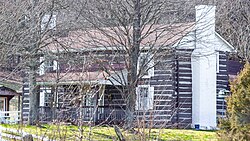| King Homestead | |
| U.S. National Register of Historic Places | |
 | |
  | |
| Location | About 2 miles (3.2 km) west of Cottontown, Tennessee, off Tennessee State Route 25 |
|---|---|
| Coordinates | 36°27′6″N 86°34′14″W / 36.45167°N 86.57056°W / 36.45167; -86.57056 |
| Area | 1 acre (0.40 ha) |
| Built | 1798 |
| Architect | King, William |
| Architectural style | Log house |
| NRHP reference No. | 78002640 |
| Added to NRHP | January 30, 1978 |
King Homestead, renamed New Moon Farm in 1954, is a log home off Tennessee State Route 25 located near Cottontown, in Sumner County, Tennessee. It was built in 1796 by William King as the first home for himself and his new bride, Caroline Hassell, married on Christmas Day of the same year. The home remained in the King family for one hundred years, and a large farming operation was conducted on the property with the use of up to 30 enslaved people. The property and home were sold numerous times, falling into disrepair. The home has undergone renovation and was placed on the National Register of Historic Places in January 30, 1978.
It was built originally as a single pen log house. In 1978 it was a two-story double pen with its front entrance into an enclosed former dogtrot.
References
- "National Register Information System". National Register of Historic Places. National Park Service. March 13, 2009.
- Debbie Hen.derson; Gail Hammerquist (May 1977). "National Register of Historic Places Inventory/Nomination: King Homestead / Greer House". National Park Service. Retrieved December 24, 2017. With three photos from 1976.
- Sumner County Fact Book 2007-2008. The News Examiner & The Hendersonville Star News. 2007.
| U.S. National Register of Historic Places | |
|---|---|
| Topics | |
| Lists by state |
|
| Lists by insular areas | |
| Lists by associated state | |
| Other areas | |
| Related | |
This Tennessee building- or structure-related article is a stub. You can help Misplaced Pages by expanding it. |
This article about a property in Sumner County, Tennessee on the National Register of Historic Places is a stub. You can help Misplaced Pages by expanding it. |